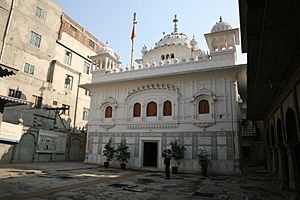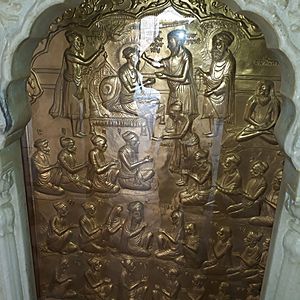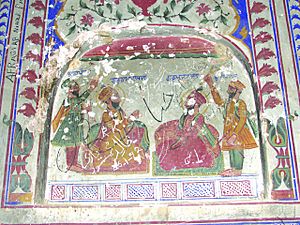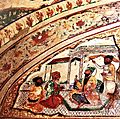Guru Ram Das facts for kids
Quick facts for kids Guru Ram Das |
|
|---|---|
| ਗੁਰੂ ਰਾਮ ਦਾਸ | |
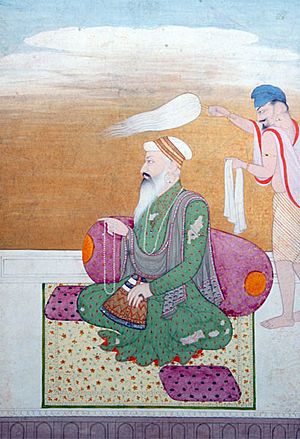
Guru Ram Das (seated) being fanned by attendee
|
|
| Religion | Sikhism |
| Known for | founder of Amritsar city |
| Other names | Fourth Master Fourth Nanak |
| Personal | |
| Born | Jetha Mal Sodhi 24 September 1534 Chuna Mandi, Lahore, Mughal Empire |
| Died | 1 September 1581 (aged 46) Goindwal, Mughal Empire |
| Spouse | Bibi Bhani |
| Children | Prithi Chand (1554 - 1623) Mahan Dev (1559 - 1656) Guru Arjan (1563 - 1606) |
| Parents | Hari Das and Mata Daya |
| Religious career | |
| Based in | Ramdaspur |
| Predecessor | Guru Amar Das |
| Successor | Guru Arjan |
| Signature |  |
Guru Ram Das (Gurmukhi: ਗੁਰੂ ਰਾਮ ਦਾਸ, pronunciation: [gʊɾuː ɾaːmᵊ d̯aːsᵊ]) was the fourth of the ten Sikh Gurus. He was born on September 24, 1534, in Lahore. His birth name was Jetha. Sadly, he became an orphan at age seven. After that, he was raised by his grandmother in a village.
When he was 12, Bhai Jetha and his grandmother moved to Goindval. There, they met Guru Amar Das, the third Sikh Guru. Bhai Jetha chose Guru Amar Das as his teacher and served him with great dedication. Later, Bhai Jetha married Bibi Bhani, the daughter of Guru Amar Das.
Guru Amar Das chose Bhai Jetha as his successor. He did this because of Bhai Jetha's excellent service and selfless devotion. He renamed him Ram Das, which means "servant of God." Guru Ram Das became the Guru of Sikhism in 1574. He served as the fourth Guru until 1581.
Guru Ram Das moved his base to a new town called Guru-ka-Chak. This town was later named Ramdaspur, and it grew into Amritsar. Today, Amritsar is the holiest city for Sikhs. Guru Ram Das also helped expand the manji system. This system helped organize the Sikh community and collect donations. Unlike the first four Gurus, the Gurus who came after Guru Ram Das were his direct descendants.
Contents
Early Life and Family
Bhai Jetha was born on September 24, 1534. His family belonged to the Sodhi clan of the Khatri caste. His parents, Sri Hari Das and Mata Daya, both passed away when he was seven years old. His grandmother then took him to her village, Besarke, where he lived for five years.
In 1546, Ram Das went to Khadur. He attended the gatherings of Guru Angad, the second Sikh Guru. He developed a strong liking for Guru Angad and Guru Amar Das. When Guru Amar Das settled in Goindwal in 1552, Ram Das also moved there. He spent most of his time at the Guru's court.
In 1553, he married Bibi Bhani, the younger daughter of Guru Amar Das. They had three sons: Prithi Chand, Mahadev, and Guru Arjan. Before becoming Guru, Ram Das also represented Guru Amar Das in the Mughal court.
Becoming the Guru
Ram Das became the Guru in 1574, when he was 40 years old. He held this important position for seven years. Guru Ram Das is well-known for building the city of Amritsar.
There are two main stories about how the land for Amritsar was chosen. One story says the land was bought with Sikh donations for 700 rupees. It was purchased from the owners of the village of Tung.
Another story, from Sikh history, says that Guru Amar Das chose the site. He called it Guru Da Chakk. He asked Guru Ram Das to find land to start a new town. This town would have a man-made pool at its center. After becoming Guru in 1574, Guru Ram Das founded the town. He named it "Ramdaspur" after himself.
He started by finishing the pool. Then, he built his new official Guru center and home next to it. He invited merchants and skilled workers from other parts of India to live in the new town. The town grew even more during the time of Guru Arjan, his son. This growth was supported by donations and built by volunteers. The town became the city of Amritsar. The pool area grew into a temple complex after Guru Arjan built the Harmandir Sahib. He also placed the holy Sikh scripture inside the new temple in 1604.
Important Contributions
Holy Hymns
Guru Ram Das wrote 638 hymns. This is about ten percent of all the hymns in the Guru Granth Sahib, the holy scripture of Sikhism. He was a very talented poet. He wrote his works in 30 ancient ragas, which are musical forms in Indian classical music.
His beautiful compositions are still sung every day in the Harmandir Sahib in Amritsar.
Wedding Hymn
Guru Ram Das, along with Guru Amar Das, wrote parts of the Anand and Laavan compositions. These are sung during Sikh weddings. In a Sikh wedding, the bride and groom walk clockwise around the Guru Granth Sahib four times. This ceremony is called Anand Karaj.
The Laavan hymn was written by Guru Ram Das for his own daughter's wedding. The first part of the hymn talks about living a good family life and following the Guru's teachings. It also reminds people to remember God's name. The second part speaks about finding God everywhere and within oneself. The third part talks about divine love. The fourth part reminds us that the joining of two people in marriage is like the joining of a person with God.
Masand System
Guru Amar Das started the manji system to organize the Sikh community. Guru Ram Das expanded this system by adding the masand institution. Masands were Sikh community leaders who lived far from the Guru. They helped lead the Sikh groups in distant places. They also collected donations for Sikh activities and for building gurdwaras (Sikh temples).
This system helped Sikhism grow a lot in the years that followed. However, later on, some masands became corrupt. This caused problems and was sometimes used to support rival Sikh groups during disagreements over who would be the next Guru.
Death and Successor
Guru Ram Das passed away on September 1, 1581, in Goindwal. He chose his youngest son, Guru Arjan, to be his successor. His eldest son, Prithi Chand, was not happy with this decision. He felt that the Guruship should have been his. He even tried to cause problems for Guru Arjan. However, other writings say that Prithi Chand was devoted to his younger brother. These writings also say that Prithi Chand became a Guru after Guru Arjan's death and disagreed with Guru Hargobind becoming the next Guru.
Images for kids
See also
 In Spanish: Gurú Ram Das para niños
In Spanish: Gurú Ram Das para niños


